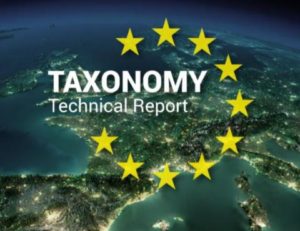
The EU Green Deal, climate neutrality, sustainable economic growth, and inclusion of all countries, a classification system for sustainable activities fulfils a key role, i.e. an EU Taxonomy. In March this year, the Technical Expert Group (TEG) on Sustainable Finance published its final report containing recommendations on the EU Taxonomy, including an overarching design as well as extensive technical screening criteria. Sustainalize organized three webinars about this EU Taxonomy, clarifying the possible implications and timeline for governments, companies and financial institutions in consultation with experts.
Although the corona crisis focus is on providing care and keeping our economy running, there is also a realization that the world is changing rapidly; The world is not only facing major transformations in the economic and geopolitical field, but environmental and social issues also require a change in thinking, acting and making our current systems fit-for-the future.
The EU Taxonomy is an important guideline in this context, and the introduction is fast approaching. The first delegated acts will be published end of the end, obliging governments, companies and financial institutions, resulting in significant impacts. The great interest in the series of webinars organized by Sustainalize at the end of May showed that many companies are uncertain about the content and implications and that there is a great need for information. In short, we can outline the most important steps.
- The first actions are for companies that have to report according to the Non-Financial Reporting Directive (NFRD). The deadlines for this are short. From 2022, the EU Taxonomy needs to be part of the reporting and experience shows that the remaining year and a half will be more than necessary for integration with reporting systems.
- In the same period, financial institutions face challenges to report figures on the alignment with the taxonomy of their portfolio; in this interim period, they will probably have to base themselves partly on their own assumptions. In addition, they will have to actively approach the companies in their portfolios in order to provide the necessary insights.
- On the medium term, the impact will focus on refuting financial flows and thus have major implications for many sectors. Expectations to report in line with the EU Taxonomy are ambitious and will, therefore, provide a major incentive to accelerate transitions.
- Finally, apart from drawing up and implementing laws and regulations, governments will play a role. In many countries, they are the engine for driving transitions and at the same time they are an important investor in sectors within the scope of the EU Taxonomy. The actions will not stop at a national level, cities and regions will also be forced to use the EU Taxonomy in their activities.
During the three webinars, we discussed the ins and outs with members of the TEG. During these conversations it was not denied that reality will be tough; however, the difficulty does not lie in the EU Taxonomy, which is built around a logical structure, but mainly in the translation into practice. An early start and sharing of experiences are essential to mitigate risks. Examples of this are already available, such as from the French company SPIE.
Read the full article and view the webinars!



